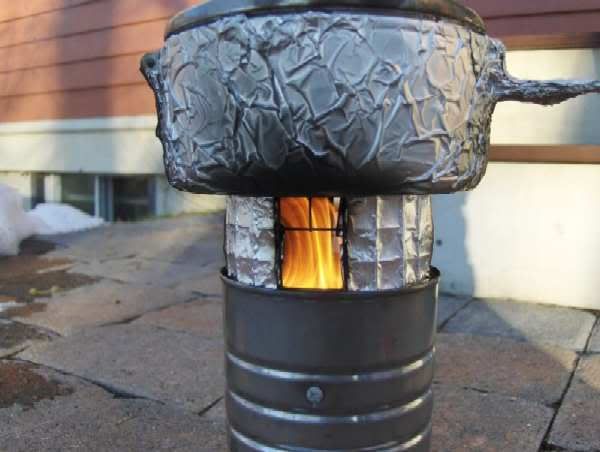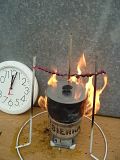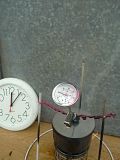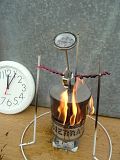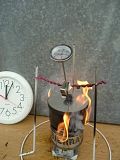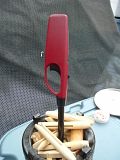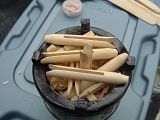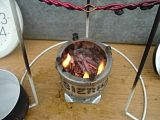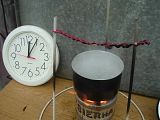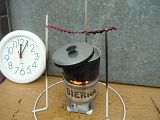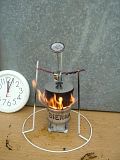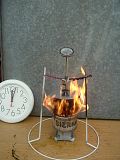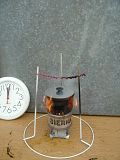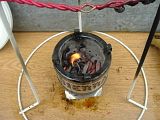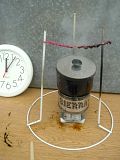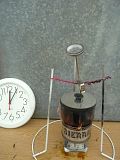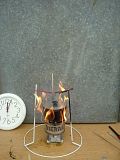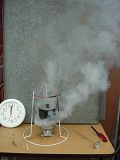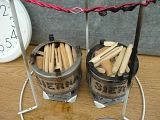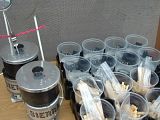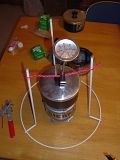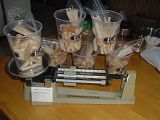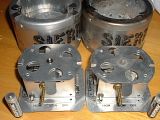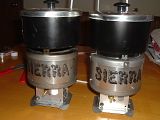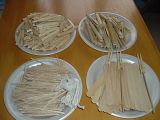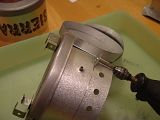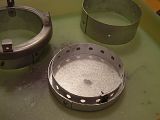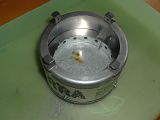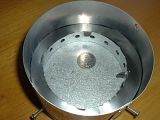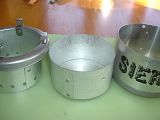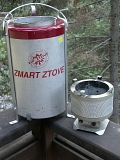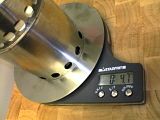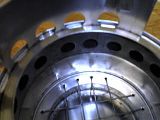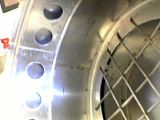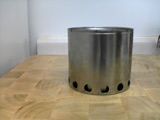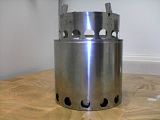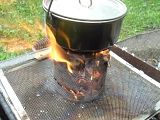Topic
has anyone tried this wood burning stove?
Forum Posting
A Membership is required to post in the forums. Login or become a member to post in the member forums!
Home › Forums › Gear Forums › Make Your Own Gear › has anyone tried this wood burning stove?
- This topic is empty.
-
AuthorPosts
-
Oct 23, 2007 at 11:31 pm #1406449
Check out the posts from last February/March here .
I've since added pot supports to allow heat to rise up all sides of the pot rather than just at the fuel port. Also, the fuel size and 'feed rate' during the initial tests weren't optimal, causing a quick, hot burn. Much of the heat rose up past the pot and was wasted. I haven't tinkered with the design since, but believe it still has promise.
Oct 24, 2007 at 7:05 am #1406462Risk's WoodGas Stove which is a derivate of the Garlington Wood Gas Stove
Some others at Wood Burning Stoves
Oct 24, 2007 at 8:57 pm #1406582Thanks Guys, that was exactly what I was looking for.
Oct 26, 2007 at 2:29 pm #1406765The two stoves Joshua linked aren't woodgas stoves, these are something like "chimney wood burning stove with air preheater". The double wall of the downdraft gasifier doesn't serve as an air preheater, it conducts the gas, mixed with air at the bottom of the stove, to the jets in the upper part of the stove.
Downdraft gasifier must have the gap between the two shells closed to work properly. The flames emerge from the jets in the inner wall. Majority of the flame goes up and escapes from the stove, while some fraction of it is sucked downwards by the draft. This hot gas gasifes the wood instead of normal burning, because oxygen in it was already consumed in the flame.
Here is a simple scheme how it works:
 Oct 26, 2007 at 5:34 pm #1406785
Oct 26, 2007 at 5:34 pm #1406785I've got a picture of one I designed at http://stores.lulu.com/ultralight (scroll down about one screen — it's the one on the left).
It's based on the Rick Allnutt and Ray Garlington designs, plus a little other research.
I like the reply and diagram from Jan Rezac. See "These are not woodgas stoves."
According to his comments mine isn't one either, but the point is that it works, weighs 3.8 ounces, and is all one piece. It does require flat ground and a flame-proof sheet underneath on flammable ground, but it works well.
The key for me is that a stove like this can burn fuel from the top down. Smoke is generated at the bottom and is burned as it rises through the flame. Whether or not there are ducts, double walls, preheating, and a pedigree are separate issues. My stove burns about 95 percent smoke free and dies out quietly, leaving just a bit of clean ash.
The designs I started with were called "inverted downdraft batch gassifiers" (i.e., updraft smoke-burners) and that's what I call this one. I'm in favor of anything that works, and almost always use alcohol anyway, but it's good to experiment.
Thanks also to Lance Marshall for the link to "posts from last February/March", which is interesting as well.
Oct 29, 2007 at 9:06 am #1407018"Downdraft gasifier must have the gap between the two shells closed to work properly."
Jon, I presume you are talking about the gap between the upper parts of the walls?
Restricting this (rather than fully blocking it) would result in partial gasification (as I've heard the stoves I've linked to referred to) would it not? Basically, you can tell if some gasification is occurring by the nature of the flame pattern at the top of the stove.
Another thing you haven't mentioned, but is particularly important to these passive down draft gasifier stoves is that, to get true gasification nearly all need to bit top-lit, otherwise true gasification doesn't occur until very near the end of the burn cycle (when there's a dense enough collection of embers to prevent the primary combustion oxygen from simply rising up through the main burn area around the fuel)
PS – I understand your point, and really like your diagram (its a better diagram than I've ever seen anywhere)… the detailed points you've brought up, however, tend to confuse people who are new to the whole MYOG Woodstove arena. The Woodgas stoves are 'close enough' to what most people are looking for when considering an alternative to the BB.
Nov 2, 2007 at 12:30 am #1407530dave:
Would you mind providing your wood burning design? I'm also curious about your pot/stove alcohol combination.
-Michael
Feb 13, 2008 at 10:54 am #1420468I have built a homemade stove out of British cans that works and has a flame pattern like a Bushbuddy. Although people call these downdraught gassifiers they are not. Without powered fans hot air always rises. What happens with the bushbuddy is that some primary air comes in the outer casing, over the ashpit, and burns the wood upward. Smoke and invisible CO and volatiles and flames come out the top of the wood. Meanwhile some other air comes in the outer casing and is preheated in the annular space between the walls. It comes out at the top of the firebox and what you see is a jet of hot air burning as a flame in the burnable gases and flame over the wood. No woodgas leaves downward through the grate, because the flow of air is in the other direction. so an updraught gassifier with preheated air. It works best fed steadily, not in batches.
Downdraft gassifiers need powered fans to drive the gases the wrong way, they probably do work best batch fed.
My stove and its 1 litre pot and foil windscreen weighs 200 gram, just over 7 ounces. Everything nests in the pot to make a package 110mm 4 1/4 " diameter 160mm high 6 1/2"Feb 13, 2008 at 7:28 pm #1420525I'm in total agreement with you. They are all updraft stoves. I also believe the double walled stoves are for naught. The inner wall is a waste of material.
All of these stove builders that say burning woodgas is coming out of their top holes are in denial. I agree with you, its just air coming out and passing through the rising flames coming from the center of the stove.
How is it they can think for a minute that air could be flowing downward into the bottom of the stove is beyond my understanding. Ther is no such thing as a downdraft woodburner in the backpacking world.
All fuel needs to be gassified in order to burn. The process starts with a match. The burning match heats the twigs into gassification and then the flame on the match ignites the gas.
The Garlington creates charcoal in the process of burning. Charcoal is produced because of insuficient oxygen being present. The garlington is a slow burner because the twigs burn from the top down. It is a very difficult stove to light evenly to have it burn properly. I don't see how in the world he ever got 1 quart of water to boil with such a small amount of twigs. Anyone else built one and tested it?
I think these backpacking gassifier stoves are borderlining on Urban Legend. They are just hobo stoves with names attached to make them to make them sound like something special. Some have so many parts and are so heavy it makes me laugh.
Feb 14, 2008 at 4:38 am #1420547Whilst it is nice to be agreed with, my personal view is that there may be an advantage in preheating the secondary air. My preheat jacket is an aluminium can and only weighs 20 gram. Before the stove is up to temperature it produces lots of white volatile smoke. It is great when suddenly the secondary air gets hot enough and you get flames instead. I believe you get faster boil times, 5min from cold for 500ml, because of the extra efficiency. I dont like producing smoke, and although the fuel is free sometimes there is a shortage of fuel. I can see it is in part down to philosophy and on the right occasion a big camp fire is much better than a minimal twig stove.
Perhaps the issue is how much bigger a simple firebox can you make for 20 gram.Feb 14, 2008 at 11:52 am #1420584I think Derek hit the nail on the head, there's no wood gas going up the side walls, but the preheated air seems to create much less smoke and offer a tighter flame pattern. The double-walled stove that I've been playing around with seems to direct the flame at the bottom of the pot much better than the empty tin can I started with.

Is the second wall worth any extra weight? I don't know yet. One could ask if any "wood stove" is much more than a glorifed pot stand and wind screen. I guess we need to see some head-to-head numbers using the same amount of wood material.
best,
vino vampireFeb 14, 2008 at 1:17 pm #1420598I wqould swear my stove with preheated secondary air will boil more water from the same fuel than a hobo stove. If fuel is free some people would say that fuel efficiency is not an important crieria.
Here is a description of my stove and the pot it nests with.
My 1 litre pot is the bottom 1 Litre of an Asahi Japanese 2litre beer can, my preheat jacket uses the top part with the conical top cut off to leave a ring that hangs it from the top rim of a steel firebox can. The jacket has a vertical slit, almost to the top, to allow it to nest over the pot for storage.
my fire box can is 100mm diameter by 120mm high, steel. There are many such cans in UK. It is divided: 20mm of ashpit then a grate,(this sits on 2 titanium tent stakes) then 100mm of firebox with a ring of secondary air inlet holes at the top. A little bit of the can top is retained as a ledge for: a 95mm diameter by 100 high 1 lb treacle tin as a pot stand, this also nests for storage. I also manage to roll a large foil turkey envelope folded around the firebox and fit it in the pot. This is a very good high windshield that reaches halfway up the pot. total weight 200 gramFeb 14, 2008 at 5:57 pm #1420633derek, I did some testing of double walled vs single wall zip stoves. I'll post the photos and answer questions if anyone has any. I modified a zip by removing the inner wall and compared it to an unmodified zip. The modified was a tad more efficient than the double wall. If any one is interested in the entire story and info I'll furnish a link to Whiteblaze.net where the original postings took place.
Feb 15, 2008 at 2:16 am #1420678The zip stove is new to me. Forgive me if I am wrong but it looks as if it has a fan but that that fan acts to give more and preheated primary air. If that is true the stove will light and stay lit better than one without power assist but it wont be much more efficient. Preheating SECONDARY air which bypasses all the solid fuel and mixes with and burns the smoke, CO and volatiles is where extra efficiency comes from. I cannot see any holes above the fire box which would allow preheated air to mix with the smoke. As a further criticism of the zip design There is also no room for any secondary burning to take place before the fumes are quenched by cooling from the pot.
As my father told me to burn the secondary air effectively you need the 3 T's: Time, Temperature and Tubulence.
So if your test was with powered and preheated primary air versus powered but not preheated ( because you took out the inner jacket). Then I would expect very little difference in efficiency.
My stove and the bushbuddy definitely supply the preheated air above the fuel. The primary air that goes through the fuel from below is not preheated.Feb 15, 2008 at 7:01 am #1420690These are the test results of the Modified and Unmodified Sierra Zip Stove. Three test burns were conducted on each stove, on the same day:
Boil times for each stove:
Unmodified: Test one: 5 1/2 min.
Test two: 5 min.
Test three: 6 min
Modified: Test one: 4 1/2 min.
Test two: 4 min.
Test three: 4 1/2 min.
What are our conclusions based on these results?
To get a better understanding to the photos that I included in the above post, visit Whiteblaze.net to view the one page thread Modified Sierra Zip Stove
Feb 15, 2008 at 8:07 am #1420696WEll done for these tests I think you have shown that preheating primary air in a forced draft Zip stove reduces speed of boil. I would say the little fan is pushing more air through the less convoluted path of your modified stove and so you are getting a faster boil. Maybe this is what we all want, but I think efficiency is another concept.
To my mind the test of fuel efficiency is how much increase in temperature of standard large volume of water is produced by a standard load of wood in different stoves.
So with the same wood stove A gets 10 litres from 10-70 degree C, stove B 10-80 degree C before it goes out. Stove B is the most efficient.
I think first we need to decide on our criteria for success. Is it faster boil? the same task done with less fuel? minimum smoke? no scar on the ground?
I must say powered stoves are heavier than I am willing to carry backpacking.
If I was modifying the zip stove for efficiency. I would put back the double wall, drill holes around the top of the inner wall, (so that at least half the air came out that way) to let preheated secondary air out above the fuel and raise the pot 75mm with a bigger pot stand. I would use a windshield around all that in any wind at all.
I would predict that would be efficient, and relatively smokeless, but it might not win on speed of boil.Feb 15, 2008 at 8:25 am #1420698I have seen these on Ebay and they look pretty interesting. I wonder if anyone has experience with it? http://cgi.ebay.com/Wood-Backpacking-Hiking-Camp-Alcohol-Stove-Stoves_W0QQitemZ270210955480QQihZ017QQcategoryZ87136QQssPageNameZWDVWQQrdZ1QQcmdZViewItem
Feb 15, 2008 at 8:28 am #1420699You are all correct that these are not downdraft stoves. But you are incorrect that they are not gassifiers, and that they are some kind of urban legend. Whether the technology is best put to use for backpacking is another question.
Technically the Bushbuddy and its kin are inverted-downdraft-gassifiers. Gassification happens when you force air downward through a hopper toward a burn chamber. When the combustible material gets close to the combustion, it begins to smolder, i.e. gassify. What the forced air does is force this smoke downward and through the hot coals.
see http://www.alternativefuelboilers.com/gasification_video.wmv
for a demonstration of how it works in a home heater.Since this smoldering uses up the available oxygen as CO and H2 (et al.) are produced, more 0^2 must be introduced in order for the gases ignite. The ignition of these gases is secondary combustion.
That is what we are seeing as the flames exit the top holes of the Bushbuddy. Plug those upper holes and you would have a smudge pot. Contrary to what appears to be the popular wisdom, it is not the preheating of the secondary air that is most important (though it is not insignificant); it is the draft of fresh oxygen.
Inverted down-draft gassifiers are also known as top-lit-updraft-gassifiers, and have quite a following among third-world development workers, with improvements in efficiency over an open fire by three to four times. See the discussions at http://www.repp.org/discussiongroups/resources/stoves/
These tinkerers are not just interested in efficiency, but in smoke and the other dangerous chemicals given off by non-complete combustion (ever gotten a headache from wood smoke? That's carbon-monoxide poisoning.)see also http://www.woodgas.com/
Another thing that is missed is that true "top-lit-updraft-gassifiers" must be lit from the top, like Garlington describes. The Bushbuddy can be a pure t-lud stove if it is treated like one, but it is typically a kind of hybrid which works on the same principles. If anyone fiddles around, they will find that the _cleanest_ burn overall will result from starting the fire with some alcohol soaked pieces of wood on top.
Perhaps the most important thing the tlud burners do is regulate primary and secondary air supply; hence regulating primary and secondary combustion. I found the Garlington burner most unsatisfactory. I know now that it is because there was too much primary air feeding the "smolder" stage, and not enough secondary air feeding the "combustion" stage. The Bushbuddy has this carefully regulated—at about four times more secondary air than primary air (measure the intake below the ash pan, which is very hard to see, and compare it to the combined diameter of the upper burn chamber holes). This keeps the smoldering happening at a good enough clip to boil our water, but not so fast as to provide more smoke than the oxygen in the secondary air can combust. Hence the "clean as a candle."
By the way, every kind of wood or biomass fire, even an open one, is a kind of "gassifier," because combustion always happens in two stages: gassification of volatile organic compounds (i.e. smoke), then combustion of these gasses (flames). A well-built teepee fire will be smokeless—but notice how high the flames climb. They climb in search of more oxygen. What all kinds of stoves do is concentrate the heat and regulate oxygen to create more complete combustion and more efficient heat-transfer.
Good technique and patience to create dry wood and find a sheltered spot can make any fire at least efficient enough for backpacking. But who wants to spend that much time (in our precious time in the wilderness, anyway: I like wasting days with fire while at home) fiddling with fire?
And beyond all that, I love my Bushbuddy not because its the best possible solution, but because it is a well-thought, handsomely produced design. If this weren't what caused us to buy stuff in the first place, we'd all be sleeping dry and happy and rich under plastic tarps in dressed in thrift-store synthetics. I do that too, but even in my thriftyness, every once and a while a thing of beauty comes along whose concept and construction are good enough to arrest me.
Andrew "Cheapweight" Wilson
Feb 15, 2008 at 10:10 am #1420715These two guys are the culprits that came up with the name "Inverted downdraft Gasifiers" :
T. B. Reed and Ronal Larson
The Biomass Energy Foundation, Golden, CO., USAI quote a small amount of what they said:
(quote) In 1985 we developed the “inverted downdraft gasifier” (also called “upside downdraft,
or pyrolysing gasifier) operating on natural draft. The name comes from the fact that the fuel
charge is lit ON THE TOP, and forms a layer of charcoal there; the flaming pyrolysis zone is
below that; the unburned fuel is on the bottom of the pile, and primary air for pyrolytic
4
gasification enters at the bottom and moves UP, forming gas in the flaming pyrolysis zone, as
shown in Fig. 2.
At that time we built a clean, efficient stove using a jet of compressed air to mix
secondary air with the gas and a venturi burner to hold the flame. However, developing country
households typically do not have compressed air, so we began development of a natural draft,
close coupled cooking gasifier. In 1991 we described a cooking stove based on the inverted
downdraft gasifier with natural draft secondary air entering the gasifier above the charcoal zone.
The combustion in this stove was relatively clean, but the poor air-gas mixing resulted in a
unstable, partly yellow flame. The stove is marketed under the name “GAS-I-FIRE”. [4](end of quote)This is a diagram of the stove of which they refer to as figure 2:
.
Feb 15, 2008 at 12:11 pm #1420738I think Andrew is agreeing with me but hasnt understood me.
Surely we dont need to call an updraught stove an inverted down draught stove. On a bushbuddy level I have tried lighting at the bottom by dropping a flaming firelighter down a hole and lighting at the top.Within a minute the whole firebox is alight so itop lit or bottom lit makes little difference.
The only thing I am sure I disagree with Andrew about is he puts too little emphasis on the preheating of the secondary air in the bushbuddy. Before the bushbuddy gets warm enough to preheat the secondary air it smokes large quatities of white smoke and then when the secondary air temperature rises suddenly we have flames as the preheated air mixes with the smoke and burns. To repeat my father's saying "secondary combustion needs all 3 T's including temperature".Feb 15, 2008 at 1:01 pm #1420749Andrew has alot of stuff all mixed up in there. Lots that I disagree with and some that I agree with.
Derek, it's not the preheated air that ignites the SMOKE, it's flame from under the smoke that makes it's to the top edge of the stove. Once there, all three elements are present OXYGEN, HEAT(Flame that made it's way to the top, FUEL(In the form of volital gases in the smoke)
Next time you use your stove, put a match to the top edge of the stove where the smoke is coming out. It will ignite the smoke/gasses. Same thing occurs when you blow out a candle, it starts to smoke, draw a lit match close to the smoke and watch the flame of the match jump kinda jump towards the smoke and ignite it. That's what is occuring at the top of the stove. Warmed air is not igniting the gasses. Just a side note: Cold air(condensed) contains more oxygen molecules than (expanded) warm air.
Ask your father about what is necessary to acheive fire.
Early on as a trained fire fighter we learned never to break a window of a burning structure until told to do so. To do so would allow oxygen in and fuel the smouldering fire within into a raging fire. Only when the firefighters are in position with charged lines would the windows be broken to allow the water to be discharged into the structure.
ZMART ZTOVE and also the Sierra Zip
(quote)FRED W HOTTENROTH
HIGH EFFICIENCY, LOW COST, QUICK START, LITTLE SMOKE, LONG LIFE
By F.W. Hottenroth
The ZMART ZTOVE is a stove with a very high efficiency rating. The School of Energy of Bharathidasan University in India has carefully tested it in accordance with the percent heat utilised procedure outlined by VITA. The efficiency in bringing 10 kg of water from ambient temperature to boiling measured better than 55% on the average of four tests run on consecutive days. The DNES in India requires an efficiency of only 20% for a stove to be deemed acceptable as an "Improved Stove".
The high efficiency of the ZMART ZTOVE has been achieved by combining high combustion efficiency with careful focusing of most of the generated heat on the surface of the cooking vessel.
High combustion efficiency and a hot fire generally go hand in hand. To assure a hot fire, the ZMART ZTOVE contains the burning fuel within a well insulated cylinder. Air for combustion is preheated so it will not chill the fire and slow down combustion. When the stove is lit, brisk tongues of flame are seen moving almost vertically across the normal upward path of the fire. The high combustion efficiency of the ZMART ZTOVE is evident by the small amount of smoke generated in normal usage.
Focusing of generated heat on the cooking vessel by the ZMART ZTOVE is far from perfect but it is reasonably effective. The fire is contained within a cylinder of good insulating material such as vermiculite of diatomaceous silica, materials which have five times the insulation value of sand. This cylinder effectively limits the amount of heat moving radially out from the fire.
A radiant reflector under the grate stops downward heat loss. Open fires and most stoves waste a considerable amount of their heat energy in heating the ground. The ground under the ZMART ZTOVE remains cool.
Most of the generated heat energy from the wood is directed upward against the bottom of the cooking vessel. According to the tests of Bharathudasan University it took less that 0.5 Kg of wood to boil 10 Kg of water and there was more than 0.1 Kg of charcoal remaining from the initial 0.5 Kg of wood.
The high efficiency of the ZMART ZTOVE has been achieved with a low cost product. It is composed of a few simple parts which can be readily produced using elementary sheet metal equipment. It should be produced under proper supervision to assure good quality. Factory type production is mandatory to provide the quantities needed so every wood- burning family will be equipped with an efficient stove by the turn of the century.
It has been estimated that it can be built in India to sell in India at a retail price which can be paid back out of savings in fuel wood expenditures in six weeks. Similar figures may be anticipated for other countries.
Women who have tried the ZMART ZTOVE like it because it starts so quickly and has such little smoke. It cooks fast and requires little attention. It has been designed to upgrade their status from cooking over a three stone open fire to cooking on a modern stove in a comfortable posture. Most women will want to advance quickly from a single stove to a two burner or three burner stove. The ZMART ZTOVE lends itself to this programme. Additional burners can be added as desired.
The ZMART ZTOVE is designed for long, trouble free life. The housing, legs and pot supports will last indefinitely. The burner bowl should give many months of service in spite of the extremely hot fire within. Life tests indicate that burners operating at maximum output for six month equivalent usage show no serious deterioration. If a burner bowl does burn out after hard usage, it can be simply lifted out and a new, low cost burner bowl put in to take its place.
Z Z Corp is now seeking licensees to make and market ZMART ZTOVES in other countries where wood shortages are causing problems. Z Z can furnish detailed drawings and technical help to licensees plus continuing engineering assistance.
FRED W HOTTENROTH, PRESIDENT
Z Z CORP (end quote)
The Bush Buddy burns well because it allows all the oxygen it wants to ignite a well prepared fire bed. No alcohol necessary if you know how to build the fire. Proper tinder, stacking of the DRY fuel no restrictions around the stove etc. Look at all the holes that let in air for the bb.
The 2 stoves on the bottom are the "Globe Stove". Made of stainless steel mesh, weighs 45 grams, costs $4.00 to those that MYOG. My design. Gear Heads buy their stoves, Stovies make their own.
Feb 15, 2008 at 2:09 pm #1420760Sorry Dan, I was just assumimg that we had ignition. As well as the 3 T's we need the oxygen in the secondary air and a means of ignition. The bush buddy if fed steadily should always, after startup, have flame. I totally agree with you and was using an unreasonable shorthand. Non of this is new knowledge. My father was taught this in the late 1940's and he is now long dead. It is very difficult with a small stove to get the right mix of primary and secondary air with uneven fuel supply. Pure pyrolosis stage needs more than twice the ratio of secondary to primary air of pure charcoal burning. This is why a reasonably steady feed giving a mix of pyrolysis and charcoal combustion, is better than big batches.
I agree wholeheartedly with Andrew that the Bushbuddy is well designed, I think it could have a lighter design for the outside skin, but it is inspirational.
My stove overheats the ground it stands on so I like to put it on a rock. Carrying an insulated disk, if it had minimal weight, would be an improvement, and also as Dan points out with the Zmart stove will increase efficiency. Does anyone know the lightest design for such a thing.
For me this is a good threadFeb 15, 2008 at 4:01 pm #1420770I've been doing my best to try and follow this thread, but a lot of it is over my head. So I have a quick question that might help me understand something.
When you make charcloth you burn the cloth inside a sealed container, except for some sort of vent hole (in this example, I'm thinking of using an alcohol stove to heat the container). When The cloth starts to combust (?) you get a lot of smoke coming out of the vent hole. Ever so often that smoke will ignite and fire like the jet of an alcohol stove without having been exposed to any direct flame. I always assumed that that smoke was getting so hot that it hit its ignition point and burst into flame as soon as it got enough oxygen. Is that true? Is that what some folks are saying is happening with the preheated air in the double wall designs?
In any case, I'm inspired to try and make a wood burning stove now. Now I just have to figure out (1) which type of stove I should be making and (2) how in the world to make it.
Feb 16, 2008 at 3:03 am #1420817Casey, yes and yes, except hot air is entering smoke rather than smoke jetting out into air. If it is hot enough it ignites by itself but apply a spark or flame and it happens earlier.
Feb 16, 2008 at 8:13 am #1420830Bill Reynolds, your ebay collapsible wood stove is a fancy CAD cut-out of the Nimblewill Nomad stove. An overview of that stove and other woodburners, including woodgas, can be seen at Zen Stoves.
Thru-Hiker sells titanium sheets but is out of stock now, link on sidebar. But as seen above, it looks like stainless steel mesh is another good alternative.
-
AuthorPosts
- You must be logged in to reply to this topic.
Forum Posting
A Membership is required to post in the forums. Login or become a member to post in the member forums!
Our Community Posts are Moderated
Backpacking Light community posts are moderated and here to foster helpful and positive discussions about lightweight backpacking. Please be mindful of our values and boundaries and review our Community Guidelines prior to posting.
Get the Newsletter
Gear Research & Discovery Tools
- Browse our curated Gear Shop
- See the latest Gear Deals and Sales
- Our Recommendations
- Search for Gear on Sale with the Gear Finder
- Used Gear Swap
- Member Gear Reviews and BPL Gear Review Articles
- Browse by Gear Type or Brand.


